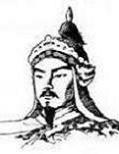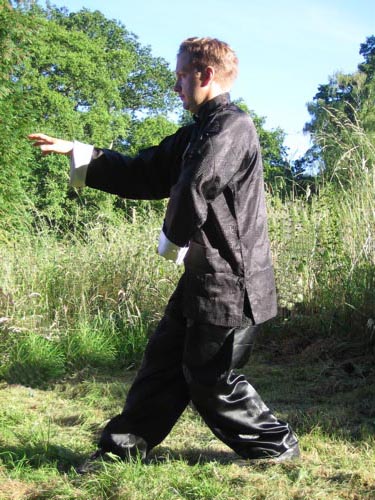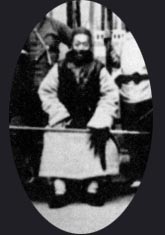
Hsing-I Chuan
Switch to solid background Switch back to transparent
Press & Media info
What's New?
 Hsing-I is a very old battlefield martial art that originated in North China
during the middle ages. Its creation is traditionally attributed to the Sung
Dynasty hero Marshal Yueh Fei (1103-1142) who trained and led the most successful
army of the time. Marshal Yueh’s army was never defeated in battle and
it was said that “It is easier to knock down a mountain than to withstand
the army of Yueh Fei”. However, corruption was rife in China at that time,
and he was unjustly imprisoned and subsequently poisoned by corrupt politicians
on his own side. In allowing himself to be sent to prison Yueh Fei took a decision
not to use his formidable military strength against his own countrymen and thus
avoided the bloodshed that civil war in China would have otherwise caused (he
was easily in a position to challenge the government because of the extreme
loyalty of his men). Thus he is considered to be a martyr. Unlike many attributed
founders of martial arts, Yueh Fei is not a mythical figure - his grave exists
to this day in Hangzhou City and his life is the subject of extensive historical
documentation. In the Sung Dynasty the primary weapons in use were spears and
swords, and this emphasis is mirrored in Hsing-I down to the present- all unarmed
fighting methods in Hsing-I can also be done with weapons and vice versa.
Hsing-I is a very old battlefield martial art that originated in North China
during the middle ages. Its creation is traditionally attributed to the Sung
Dynasty hero Marshal Yueh Fei (1103-1142) who trained and led the most successful
army of the time. Marshal Yueh’s army was never defeated in battle and
it was said that “It is easier to knock down a mountain than to withstand
the army of Yueh Fei”. However, corruption was rife in China at that time,
and he was unjustly imprisoned and subsequently poisoned by corrupt politicians
on his own side. In allowing himself to be sent to prison Yueh Fei took a decision
not to use his formidable military strength against his own countrymen and thus
avoided the bloodshed that civil war in China would have otherwise caused (he
was easily in a position to challenge the government because of the extreme
loyalty of his men). Thus he is considered to be a martyr. Unlike many attributed
founders of martial arts, Yueh Fei is not a mythical figure - his grave exists
to this day in Hangzhou City and his life is the subject of extensive historical
documentation. In the Sung Dynasty the primary weapons in use were spears and
swords, and this emphasis is mirrored in Hsing-I down to the present- all unarmed
fighting methods in Hsing-I can also be done with weapons and vice versa.
 After the death of Yueh Fei, his senior generals fled to various remote parts
of the country in order to escape a similar fate. One such area was Zhongnan
Mountain in what is now Huxian County, where they established a tradition known
as Yue Chia Quan (Yue Family Martial Arts). This was handed down through the
generations at Zhongnan and, although it was obscure, it did come to be sought
out by great fighters, particularly spear men. One such was General Tung En
Zhan, a senior commander in the Ming Army, who recommended it to his best spearman,
a non commissioned officer by the name of Ji Long Feng. Following the death
of Tung En Zhan, who suffered a very similar fate to Yueh Fei, Ji travelled
to Zhongnan in order to learn Marshal Yueh’s tradition. Ji studied at
Zhongnan for many years and found that the essence of the art was found in nature,
particularly in the characteristics of wild animals. Each animal had a “shape”
or “character” (Hsing) that enabled it to survive and be successful
in relation to the particular kinds of challenges that it met in its life. The
idea of the art was to allow the Hsing to colour the mind/spirit (I) so that
it might adapt spontaneously to different difficulties and situations. Thus
Ji came to call the art Hsing-I.
After the death of Yueh Fei, his senior generals fled to various remote parts
of the country in order to escape a similar fate. One such area was Zhongnan
Mountain in what is now Huxian County, where they established a tradition known
as Yue Chia Quan (Yue Family Martial Arts). This was handed down through the
generations at Zhongnan and, although it was obscure, it did come to be sought
out by great fighters, particularly spear men. One such was General Tung En
Zhan, a senior commander in the Ming Army, who recommended it to his best spearman,
a non commissioned officer by the name of Ji Long Feng. Following the death
of Tung En Zhan, who suffered a very similar fate to Yueh Fei, Ji travelled
to Zhongnan in order to learn Marshal Yueh’s tradition. Ji studied at
Zhongnan for many years and found that the essence of the art was found in nature,
particularly in the characteristics of wild animals. Each animal had a “shape”
or “character” (Hsing) that enabled it to survive and be successful
in relation to the particular kinds of challenges that it met in its life. The
idea of the art was to allow the Hsing to colour the mind/spirit (I) so that
it might adapt spontaneously to different difficulties and situations. Thus
Ji came to call the art Hsing-I.
 Our school of Hsing-I has been handed down to us through three different lines,
for example: Ji Long Feng taught Cao Ji Wu, who taught Dai Long Bang, who
taught Li Neng Ran, who taught Guo Yun Shen, who taught Liu Chi Lan, who taught
Li Cun Yi, who taught Hao En Guang, who taught Luo Da Cheng, who taught Zhu
Guang, who taught Damon Smith (our senior Hsing-I instructor). All three of
these lines pass through the person of Guo Yun Shen (1839-1911). In earlier
life, Master Guo ran a company that guarded traveling merchants against bandits
and other kinds of threats that were prevalent in China at that time, so he
was, like his forebears, heavily combat experienced, including fighting with
weapons, not just unarmed. Later he became a successful prize fighter, remaining
undefeated throughout his career. Later still he taught some of China’s
most famous martial artists, including Master Sun Lu Tang, founder of the
Sun Style of Tai Chi Chuan, and Master Wang Xiang Zhai, founder of Da Cheng
Chuan/Yi Chuan. He was also a close friend of Master Dong Hai Chuan, the modern
founder of Bagua Zhang.
Our school of Hsing-I has been handed down to us through three different lines,
for example: Ji Long Feng taught Cao Ji Wu, who taught Dai Long Bang, who
taught Li Neng Ran, who taught Guo Yun Shen, who taught Liu Chi Lan, who taught
Li Cun Yi, who taught Hao En Guang, who taught Luo Da Cheng, who taught Zhu
Guang, who taught Damon Smith (our senior Hsing-I instructor). All three of
these lines pass through the person of Guo Yun Shen (1839-1911). In earlier
life, Master Guo ran a company that guarded traveling merchants against bandits
and other kinds of threats that were prevalent in China at that time, so he
was, like his forebears, heavily combat experienced, including fighting with
weapons, not just unarmed. Later he became a successful prize fighter, remaining
undefeated throughout his career. Later still he taught some of China’s
most famous martial artists, including Master Sun Lu Tang, founder of the
Sun Style of Tai Chi Chuan, and Master Wang Xiang Zhai, founder of Da Cheng
Chuan/Yi Chuan. He was also a close friend of Master Dong Hai Chuan, the modern
founder of Bagua Zhang.
Today, Hsing-I exists in two main types, the Five Elements Hsing-I, which is a relatively simple, though subtle, way of fighting based on the Five Elements of Chinese philosophy, and Animals Hsing-I (the literal translation is “Shapes Hsing-I”). We study both types - Five Elements Hsing-I is a relatively quick way to learn self defence, while Animals Hsing-I presents a subtle and sophisticated long-term challenge to the experienced practitioner. In the Yongquan Hsing-I Group we study twelve different animals: Bear-Eagle, Snake, Tiger, Dragon, Chicken, Horse, Swallow, Crocodile, Goshawk, Flycatcher, Monkey and Turtle.
Hsing-I is primarily a combat art. While there are health benefits to be had by practicing the Hsing-I basics, such as the famous Three Body Posture and Five Elements Fists, it is difficult to progress far with it without being exposed to the combative nature of the art. Therefore it is not really possible to study Hsing-I “non martially” in the same way that this is possible in Tai Chi Chuan for instance. Hsing-I is well known as a “bridging art” for experienced external/hard style martial artists who want to learn more about the internal arts, and is definitely good for this purpose. This does not mean however that it is a “hard/soft style” - it is a true internal (“soft style”) martial art.

